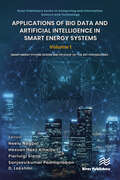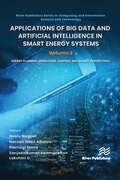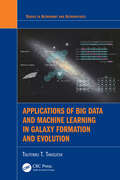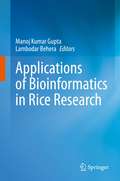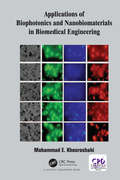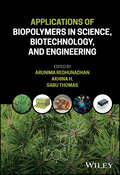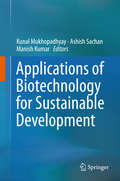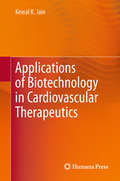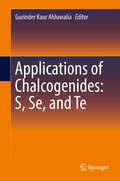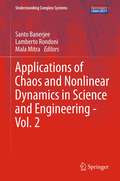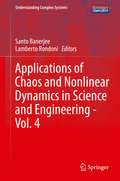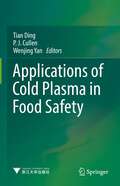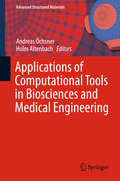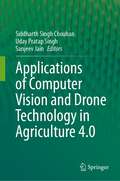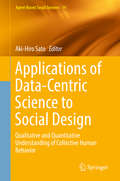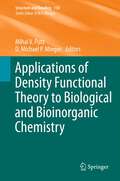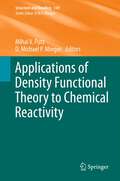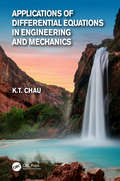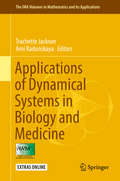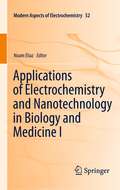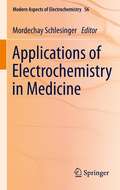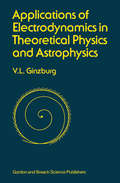- Table View
- List View
Applications of Big Data and Artificial Intelligence in Smart Energy Systems: Volume 1 Smart Energy System: Design and its State-of-The Art Technologies (River Publishers Series in Computing and Information Science and Technology)
by Neelu Nagpal Hassan Haes Alhelou Pierluigi Siano Sanjeevikumar Padmanaban D. LakshmiIn the era of propelling traditional energy systems to evolve towards smart energy systems, including power generation, energy storage systems, and electricity consumption have become more dynamic. The quality and reliability of power supply are impacted by the sporadic and rising use of electric vehicles, domestic loads, and industrial loads. Similarly, with the integration of solid state devices, renewable sources, and distributed generation, power generation processes are evolving in a variety of ways. Several cutting-edge technologies are necessary for the safe and secure operation of power systems in such a dynamic setting, including load distribution, automation, energy regulation & control, and energy trading. This book covers the applications of various big data analytics,artificial intelligence, and machine learning technologies in smart grids for demand prediction, decision-making processes, policy, and energy management. The book delves into the new technologies for modern power systems such as the Internet of Things, Blockchain for smart home and smart city solutions in depth. Technical topics discussed in the book include: • Hybrid smart energy system technologies • Smart meters • Energy demand forecasting • Use of different protocols and communication in smart energy systems • Power quality and allied issues and mitigation using AI • Intelligent transportation • Virtual power plants • AI based smart energy business models • Smart home solutions • Blockchain solutions for smart grids.
Applications of Big Data and Artificial Intelligence in Smart Energy Systems: Volume 2 Energy Planning, Operations, Control and Market Perspectives (River Publishers Series in Computing and Information Science and Technology)
by Neelu Nagpal Hassan Haes Alhelou Pierluigi Siano Sanjeevikumar Padmanaban D. LakshmiIn the era of propelling traditional energy systems to evolve towards smart energy systems, including power generation, energy storage systems, and electricity consumption have become more dynamic. The quality and reliability of power supply are impacted by the sporadic and rising use of electric vehicles, and domestic & industrial loads. Similarly, with the integration of solid state devices, renewable sources, and distributed generation, power generation processes are evolving in a variety of ways. Several cutting-edge technologies are necessary for the safe and secure operation of power systems in such a dynamic setting, including load distribution automation, energy regulation and control, and energy trading. This book covers the applications of various big data analytics, artificial intelligence, and machine learning technologies in smart grids for demand prediction, decision-making processes, policy, and energy management. The book delves into the new technologies such as the Internet of Things, blockchain, etc. for smart home solutions, and smart city solutions in depth in the context of the modern power systems. Technical topics discussed in the book include: • Hybrid smart energy system technologies • Energy demand forecasting • Use of different protocols and communication in smart energy systems • Power quality and allied issues and mitigation using AI • Intelligent transportation • Virtual power plants • AI business models.
Applications of Big Data and Machine Learning in Galaxy Formation and Evolution (Series in Astronomy and Astrophysics)
by Tsutomu T. TakeuchiAs investigations into our Universe become more complex, in-depth, and widespread, galaxy surveys are requiring state-of-the-art data scientific methods to analyze them. This book provides a practical introduction to big data in galaxy formation and evolution, introducing the astrophysical basics, before delving into the latest techniques being introduced to astronomy and astrophysics from data science. This book helps translate the cutting-edge methods into accessible guidance for those without a formal background in computer science. It is an ideal manual for astronomers and astrophysicists, in addition to graduate students and postgraduate students in science and engineering looking to learn how to apply data-science to their research.Key Features: Introduces applications of data-science methods to the exciting subject of galaxy formation and evolution Provides a practical guide to understanding cutting-edge data-scientific methods, as well as classical astrostatistical methods Summarises a vast range of statistical and informatics methods in one volume, with concrete applications to astrophysics
Applications of Bioinformatics in Rice Research
by Manoj Kumar Gupta Lambodar BeheraThis book summarizes the advanced computational methods for mapping high-density linkages and quantitative trait loci in the rice genome. It also discusses the tools for analyzing metabolomics, identifying complex polyploidy genomes, and decoding the extrachromosomal genome in rice.Further, the book highlights the application of CRISPR-Cas technology and methods for understanding the evolutionary development and the de novo evolution of genes in rice.Lastly, it discusses the role of artificial intelligence and machine learning in rice research and computational tools to analyze plant-pathogen co-evolution in rice crops.
Applications of Biophotonics and Nanobiomaterials in Biomedical Engineering
by Mohammad E. KhosroshahiThis book provides a link between different disciplines of nanophysics, biophotonics, nanobiomaterials & applications of nanobiophotonics in biomedical research and engineering. The fundamentals of light, matter, nanobiomaterials & nanophysics are discussed together, and relevant applications in biomedical engineering as well as other related factors influencing the interaction process are explicated. Theoretical and experimental research is combined, emphasizing the influence of crucial common factors on applications.
Applications of Biopolymers in Science, Biotechnology, and Engineering
by Arunima Reghunadhan Akhina H. Sabu ThomasAPPLICATIONS OF BIOPOLYMERS IN SCIENCE, BIOTECHNOLOGY, AND ENGINEERING Single volume resource covering the many different applications of biopolymers, along with foundational knowledge like biodegradability and recent advancements Along with providing in-depth discussions on the fundamentals of biopolymers, such as synthesis, fabrication technologies, and properties, Applications of Biopolymers in Science, Biotechnology, and Engineering covers the applications of biopolymers in various fields such as biotechnology, construction and civil engineering, tissue engineering, dairy technology, packaging, electronics, food, medicine, tissue engineering, and biotechnology. Overall, the text conveys a broad overview of the field, enabling readers to grasp both the fundamentals and applications of the subject. Edited by three highly qualified academics with significant experience in the field, Applications of Biopolymers in Science, Biotechnology, and Engineering covers sample topics such as: Biopolymer blends, IPNs, gels, composites, and nanocomposites, and the properties, fabrication and applications of synthetic biopolymers Role of biopolymers and their composites in sustainable agriculture, covering recent developments and future perspectives Polymers suitable for the fabrication of prosthetics, and polymers’ uses in different stages of drug delivery and drug design Life cycle analysis, biodegradability, and advances in the overall field of biopolymers, along with polymers and biopolymers in sensing applications Covering both foundational knowledge and a myriad of applications, Applications of Biopolymers in Science, Biotechnology, and Engineering is an essential resource on the subject for practitioners, researchers, and scientists in polymer science and engineering, materials science, surface science, bioengineering, chemical engineering, and any industry/field interested in biopolymers and/or nanocomposites.
Applications of Biotechnology for Sustainable Development
by Manish Kumar Kunal Mukhopadhyay Ashish SachanThis book discusses different bioprocesses to produce value-added compounds, the science behind their production, the economics of their introduction to the marketplace, their environmental impacts, and their implications for world agriculture. It also provides insights into various technologies and protocols used. The major strength of biotechnology is its multidisciplinary nature and broad range of scientific approaches. Recent advances in various biotechnological fields are facilitating the production of fine chemicals, recombinant proteins, biomaterials and pharmaceuticals. Biotechnology plays an important role, especially in the fields of food production, renewable raw materials and energy, pollution prevention and bioremediation. Biotechnology's greatest contribution is in agriculture - in making crops more efficient. Resource recovery, recycling and hazardous-waste disposal are other environmentally beneficial facets of biotechnology. Thus, biotechnology is a pivotal tool for sustainable development, which has become a priority for the world's policy makers. The concept of sustainable development is based on the goal of increasing the basic standard of living of the world's growing population, without depleting finite natural resources and degrading the environment. Emerging biotechnologies offer novel approaches with the potential to achieve the goal of sustainability and striking a balance between developmental needs and environmental conservation.
Applications of Biotechnology in Cardiovascular Therapeutics
by Kewal K. JainFor physicians, surgeons, and scientists working on cardiovascular disorders, Applications of Biotechnology in Cardiovascular Therapeutics serves as an invaluable reference by collecting the essential writings of Dr. Kewal K. Jain on the topics of biotechnology as they relate to cardiovascular disease. This thorough volume includes such subjects as biotechnology and therapeutic delivery to the cardiovascular system, cell-selective targeted drug delivery, cell and gene therapies, including antisense and RNA interference, cutting-edge gene therapy approaches, as well as personalized cardiology as a way of integrating new technologies into the selection of the best possible treatment for an individual patient. Selected references from recent literature are collected for each chapter, and the text is supplemented by a variety of useful tables and figures. Comprehensive and up-to-date, Applications of Biotechnology in Cardiovascular Therapeutics will be tremendously useful for those working in life sciences and the pharmaceutical sciences, and the inclusion of some basics of cardiovascular diseases will greatly benefit nonmedical readers as well.
Applications of Biotechnology in Oncology
by Kewal K. JainApplications of Biotechnology in Oncology collects key writings by Kewal K. Jain on the most important contributions of biotechnology to cancer research, particularly to the molecular diagnosis of cancer and drug delivery in cancer for personalized management of patients. Basics of various "omics" technologies and their application in oncology are described as oncogenomics and oncoproteomics. This detailed volume also explores molecular diagnostics, nanobiotechnology, cell and gene therapies, as well as personalized oncology. With approximately one thousand selected references from recent literature on this topic and numerous tables and figures, Applications of Biotechnology in Oncology serves as an ideal reference for oncologists, scientists involved in research on cancer biology, and physicians in various specialties who deal with cancer.
Applications of Biotribology in Biomedical Systems
by Ashwani Kumar Abhishek Kumar Avinash KumarThis book summarizes the past, present, and future work in biotribology with a special emphasis on its applications in the design and manufacture of biomedical devices and their potential future uses. The book covers several aspects of biotribology such as biocompatible materials, joint tribology, skin tribology, oral tribology, tribology of the other human bodies or tissues, animal tribology, plant tribology, medical device tribology, and more. This is an essential reference for academics, biomedical researchers, biologists, tribologists, chemists, physicists, biomedical scientists, materials engineers, mechanical engineers and other professionals in related engineering, medicine, and biomedical industries. This book can also serve as a useful research text for undergraduate and graduate engineering courses such as tribology, materials, biomaterials, material characterization, interface science, and biomedical science.
Applications of Chalcogenides: S, Se, and Te
by Gurinder Kaur AhluwaliaThis book introduces readers to a wide range of applications for elements in Group 16 of the periodic table, such as, optical fibers for communication and sensing, X-ray imaging, electrochemical sensors, data storage devices, biomedical applications, photovoltaics and IR detectors, the rationale for these uses, the future scope of their applications, and expected improvements to existing technologies. Following an introductory section, the book is broadly divided into three parts--dealing with Sulfur, Selenium, and Tellurium. The sections cover the basic structure of the elements and their compounds in bulk and nanostructured forms; properties that make these useful for various applications, followed by applications and commercial products. As the global technology revolution necessitates the search for new materials and more efficient devices in the electronics and semiconductor industry, Applications of Chalcogenides: S, Se, and Te is an ideal book for a wide range of readers in industry, government and academic research facilities looking beyond silicon for materials used in the electronic and optoelectronic industry as well as biomedical applications.
Applications of Chaos and Nonlinear Dynamics in Engineering - Vol. 1 (Understanding Complex Systems)
by Lamberto Rondoni Santo Banerjee Mala MitraChaos and nonlinear dynamics initially developed as a new emergent field with its foundation in physics and applied mathematics. The highly generic, interdisciplinary quality of the insights gained in the last few decades has spawned myriad applications in almost all branches of science and technology--and even well beyond. Wherever quantitative modeling and analysis of complex, nonlinear phenomena is required, chaos theory and its methods can play a key role. This volume concentrates on reviewing the most relevant contemporary applications of chaotic nonlinear systems as they apply to the various cutting-edge branches of engineering. The book covers the theory as applied to robotics, electronic and communication engineering (for example chaos synchronization and cryptography) as well as to civil and mechanical engineering, where its use in damage monitoring and control is explored). Featuring contributions from active and leading research groups, this collection is ideal both as a reference and as a 'recipe book' full of tried and tested, successful engineering applications
Applications of Chaos and Nonlinear Dynamics in Science and Engineering - Vol. 2 (Understanding Complex Systems)
by Lamberto Rondoni Santo Banerjee Mala MitraChaos and nonlinear dynamics initially developed as a new emergent field with its foundation in physics and applied mathematics. The highly generic, interdisciplinary quality of the insights gained in the last few decades has spawned myriad applications in almost all branches of science and technology--and even well beyond. Wherever the quantitative modeling and analysis of complex, nonlinear phenomena are required, chaos theory and its methods can play a key role. This second volume concentrates on reviewing further relevant, contemporary applications of chaotic nonlinear systems as they apply to the various cutting-edge branches of engineering. This encompasses, but is not limited to, topics such as the spread of epidemics; electronic circuits; chaos control in mechanical devices; secure communication; and digital watermarking. Featuring contributions from active and leading research groups, this collection is ideal both as a reference work and as a 'recipe book' full of tried and tested, successful engineering applications.
Applications of Chaos and Nonlinear Dynamics in Science and Engineering - Vol. 3 (Understanding Complex Systems)
by Lamberto Rondoni Santo BanerjeeChaos and nonlinear dynamics initially developed as a new emergent field with its foundation in physics and applied mathematics. The highly generic, interdisciplinary quality of the insights gained in the last few decades has spawned myriad applications in almost all branches of science and technology--and even well beyond. Wherever quantitative modeling and analysis of complex, nonlinear phenomena is required, chaos theory and its methods can play a key role. This third volume concentrates on reviewing further relevant contemporary applications of chaotic nonlinear systems as they apply to the various cutting-edge branches of engineering. This encompasses, but is not limited to, topics such fluctuation relations and chaotic dynamics in physics, fractals and their applications in epileptic seizures, as well as chaos synchronization. Featuring contributions from active and leading research groups, this collection is ideal both as a reference and as a 'recipe book' full of tried and tested, successful engineering applications.
Applications of Cold Plasma in Food Safety
by Tian Ding P. J. Cullen Wenjing YanThis book provides readers with a comprehensive overview of cold plasma technology for tackling the various food-related hazards in a wide range of food sectors. The principles and characteristics of cold plasma generation in gas and its interaction with liquids, as well as its combating modes of action for common hazards (e.g., bacteria, spores, biofilms, fungi, and fungal toxins) are emphasized in this book. It also presents the applications of cold plasma or its hurdles with other techniques to assure the microbiological safety of the key food classifications, including fruits, vegetables, cereals, grains, meat, aquatic products, liquid food products (e.g., juices, milk), nuts, spices, herbs, and food packaging. This book is useful for researchers to grasp the comprehensive understandings of how food safety can be controlled with cold plasma technology. This book also provides adequate information for engineers in food industry for better development and optimization of the plasma-generating systems. Government institutions that are responsible for food safety regulations can understand more knowledge about the intricacies and influencing factors, which should be considered for regulating the applications of cold plasma technology in food.
Applications of Computational Tools in Biosciences and Medical Engineering (Advanced Structured Materials #71)
by Andreas Öchsner Holm AltenbachThis monograph presents the latest developments and applications of computational tools related to the biosciences and medical engineering. Computational tools such as the finite element methods, computer-aided design and optimization as well as visualization techniques such as computed axial tomography open completely new research fields with a closer joining of the engineering and bio/medical area. Nevertheless, there are still hurdles since both directions are based on quite different ways of education. Often even the "language" is sometimes different from discipline to discipline. This monograph reports the results of different multi-disciplinary research projects, for example, from the areas of scaffolds and synthetic bones, implants and medical devices and medical materials. It is also shown that the application of computational methods often necessitates mathematical and experimental methods.
Applications of Computer Vision and Drone Technology in Agriculture 4.0
by Siddharth Singh Chouhan Uday Pratap Singh Sanjeev JainThis edited book focus on two most emerging areas and covers the different aspects of computer vision and drone technology in the field of agriculture. It comprises various applications including segmentation/classification of plant diseases, monitoring of crops, grade/quality estimation of fruits/flowers/vegetables/crops, surveillance, soil deficiency estimation, crop/plant growth estimation, canopy measurement, water stress management, vegetation indices calculation, weed detection, and spraying, among other. It has 17 chapters contributed by experts in the field of computer vision, drone technology, deep learning, machine learning, artificial intelligence, image processing, agriculturist, and plant pathologists. The recent development of high-end computing devices and the adaptation of unmanned aerial vehicles has provided a mechanism to automate traditional agriculture practices. The on-field or aerial images captured using cameras are processed with the help of intelligent algorithms, and an assessment is drawn for further recommendations. This practice is efficient in provisioning an accurate, timely, and economical decision-making system to overcome the problems of agricultural field experts and farmers. This process is advantageous in increasing the quality and quantity of crop yields. This book serves as an excellent guide to students, researchers, scientists, and field experts in directing their work toward this domain and developing/designing models. Further, this book is useful for pathologists, biotechnologists, seed production specialists, breeders, market managers, and other stakeholders associated with underlying technology or market development from the public and private sectors.
Applications of Data-Centric Science to Social Design: Qualitative and Quantitative Understanding of Collective Human Behavior (Agent-Based Social Systems #14)
by Aki-Hiro SatoThe intention behind this book is to illustrate the deep relation among human behavior, data-centric science, and social design. In fact, these three issues have been independently developing in different fields, although they are, of course, deeply interrelated to one another. Specifically, fundamental understanding of human behavior should be employed for investigating our human society and designing social systems. Insights and both quantitative and qualitative understandings of collective human behavior are quite useful when social systems are designed. Fundamental principles of human behavior, theoretical models of human behavior, and information cascades are addressed as aspects of human behavior. Data-driven investigation of human nature, social behavior, and societal systems are developed as aspects of data-centric science. As design aspects, how to design social systems from heterogeneous memberships is explained. There is also discussion of these three aspects—human behavior, data-centric science, and social design—independently and with regard to the relationships among them.
Applications of Density Functional Theory to Biological and Bioinorganic Chemistry (Structure and Bonding #150)
by Mihai V. Putz D Michael MingosThe series Structure and Bonding publishes critical reviews on topics of research concerned with chemical structure and bonding. The scope of the series spans the entire Periodic Table and addresses structure and bonding issues associated with all of the elements. It also focuses attention on new and developing areas of modern structural and theoretical chemistry such as nanostructures, molecular electronics, designed molecular solids, surfaces, metal clusters and supramolecular structures. Physical and spectroscopic techniques used to determine, examine and model structures fall within the purview of Structure and Bonding to the extent that the focus is on the scientific results obtained and not on specialist information concerning the techniques themselves. Issues associated with the development of bonding models and generalizations that illuminate the reactivity pathways and rates of chemical processes are also relevant. The individual volumes in the series are thematic. The goal of each volume is to give the reader, whether at a university or in industry, a comprehensive overview of an area where new insights are emerging that are of interest to a larger scientific audience. Thus each review within the volume critically surveys one aspect of that topic and places it within the context of the volume as a whole. The most significant developments of the last 5 to 10 years should be presented using selected examples to illustrate the principles discussed. A description of the physical basis of the experimental techniques that have been used to provide the primary data may also be appropriate, if it has not been covered in detail elsewhere. The coverage need not be exhaustive in data, but should rather be conceptual, concentrating on the new principles being developed that will allow the reader, who is not a specialist in the area covered, to understand the data presented. Discussion of possible future research directions in the area is welcomed. Review articles for the individual volumes are invited by the volume editors. Readership: research scientists at universities or in industry, graduate students Special offer For all customers who have a standing order to the print version of Structure and Bonding, we offer free access to the electronic volumes of the Series published in the current year via SpringerLink.
Applications of Density Functional Theory to Chemical Reactivity (Structure and Bonding #149)
by D. Michael Mingos Mihai V. PutzThe series Structure and Bonding publishes critical reviews on topics of research concerned with chemical structure and bonding. The scope of the series spans the entire Periodic Table and addresses structure and bonding issues associated with all of the elements. It also focuses attention on new and developing areas of modern structural and theoretical chemistry such as nanostructures, molecular electronics, designed molecular solids, surfaces, metal clusters and supramolecular structures. Physical and spectroscopic techniques used to determine, examine and model structures fall within the purview of Structure and Bonding to the extent that the focus is on the scientific results obtained and not on specialist information concerning the techniques themselves. Issues associated with the development of bonding models and generalizations that illuminate the reactivity pathways and rates of chemical processes are also relevant. The individual volumes in the series are thematic. The goal of each volume is to give the reader, whether at a university or in industry, a comprehensive overview of an area where new insights are emerging that are of interest to a larger scientific audience. Thus each review within the volume critically surveys one aspect of that topic and places it within the context of the volume as a whole. The most significant developments of the last 5 to 10 years should be presented using selected examples to illustrate the principles discussed. A description of the physical basis of the experimental techniques that have been used to provide the primary data may also be appropriate, if it has not been covered in detail elsewhere. The coverage need not be exhaustive in data, but should rather be conceptual, concentrating on the new principles being developed that will allow the reader, who is not a specialist in the area covered, to understand the data presented. Discussion of possible future research directions in the area is welcomed. Review articles for the individual volumes are invited by the volume editors. Readership: research scientists at universities or in industry, graduate students Special offer For all customers who have a standing order to the print version of Structure and Bonding, we offer free access to the electronic volumes of the Series published in the current year via SpringerLink.
Applications of Differential Equations in Engineering and Mechanics
by Kam Tim ChauThis second of two comprehensive reference texts on differential equations continues coverage of the essential material students they are likely to encounter in solving engineering and mechanics problems across the field - alongside a preliminary volume on theory. This book covers a very broad range of problems, including beams and columns, plates, shells, structural dynamics, catenary and cable suspension bridge, nonlinear buckling, transports and waves in fluids, geophysical fluid flows, nonlinear waves and solitons, Maxwell equations, Schrodinger equations, celestial mechanics and fracture mechanics and dynamics. The focus is on the mathematical technique for solving the differential equations involved. All readers who are concerned with and interested in engineering mechanics problems, climate change, and nanotechnology will find topics covered in this book providing valuable information and mathematics background for their multi-disciplinary research and education.
Applications of Dynamical Systems in Biology and Medicine (The IMA Volumes in Mathematics and its Applications #158)
by Trachette Jackson Ami RadunskayaThis volume highlights problems from a range of biological and medical applications that can be interpreted as questions about system behavior or control. Topics include drug resistance in cancer and malaria, biological fluid dynamics, auto-regulation in the kidney, anti-coagulation therapy, evolutionary diversification and photo-transduction. Mathematical techniques used to describe and investigate these biological and medical problems include ordinary, partial and stochastic differentiation equations, hybrid discrete-continuous approaches, as well as 2 and 3D numerical simulation.
Applications of Electrochemistry and Nanotechnology in Biology and Medicine I (Modern Aspects of Electrochemistry #52)
by Noam EliazThe study of electrochemical nanotechnology has emerged as researchers apply electrochemistry to nanoscience and nanotechnology. These two related volumes in the Modern Aspects of Electrochemistry Series review recent developments and breakthroughs in the specific application of electrochemistry and nanotechnology to biology and medicine. Internationally renowned experts contribute chapters that address both fundamental and practical aspects of several key emerging technologies in biomedicine, such as the processing of new biomaterials, biofunctionalization of surfaces, characterization of biomaterials, discovery of novel phenomena and biological processes occurring at the molecular level.
Applications of Electrochemistry in Medicine (Modern Aspects of Electrochemistry #56)
by Mordechay SchlesingerMedical Applications of Electrochemistry, a volume of the series Modern Aspects of Electrochemistry, illustrates the interdisciplinary nature of modern science by indicating the many current issues in medicine that are susceptible to solution by electrochemical methods. This book also suggests how personalized medicine can develop.
Applications of Electrodynamics in Theoretical Physics and Astrophysics
by David GinsburgTreats certain problems and methods of theoretical physics and astrophysics which are associated with microscopic and macroscopic electrodynamics and material concerning the theory of transition radiation and transition scattering.
